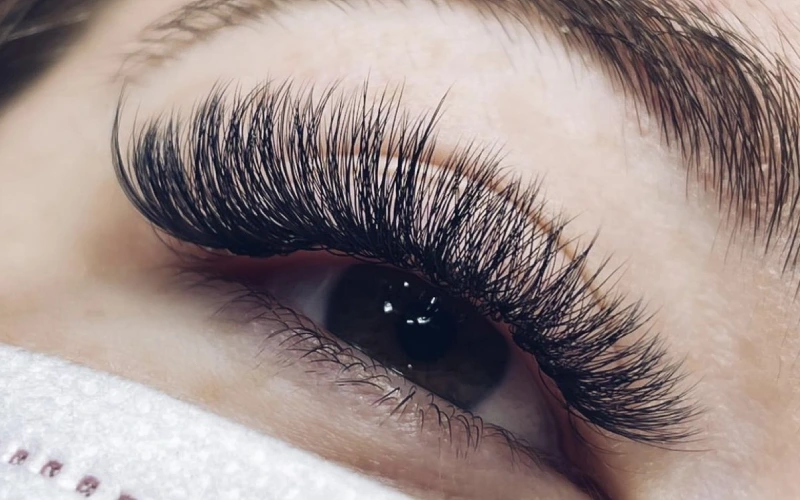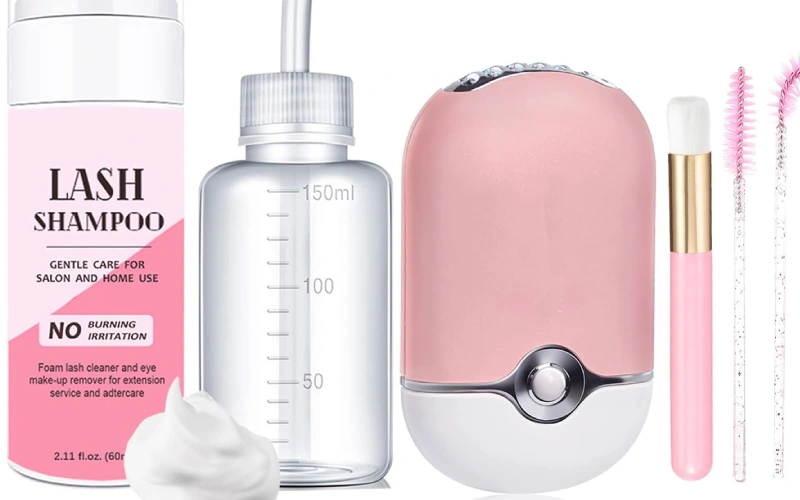![]()
False eyelashes are the inevitable choice for beauty lovers nowadays. Whether it is DIY clustered eyelashes, eyelashes extension or natural eyelashes, there is a risk of Mites. Let’s analyze it together to understand the reasons and avoid them.

What Are Eyelash Mites
Let’s face it: the idea of bugs living on your eyelashes is downright unsettling. But as unappealing as it sounds, eyelash mites, or Demodex, are very real—and surprisingly common. In fact, according to Wikipedia, nearly every adult has some form of these microscopic mites living on their skin. Most of the time, they’re harmless. But when they multiply excessively, things can get messy—itchy, red, and downright uncomfortable.

As a professional eyelash manufacturer, we’ve seen firsthand how these pests can affect lash health. From salon owners to wholesale clients, the same concerns keep popping up: lash fallout, eye discomfort, and hygiene questions. It’s more than a health issue—it’s a quality-of-life matter that affects beauty, confidence, and comfort.
Eyelash mites live in and around the base of your lashes, feeding on oil, dead skin cells, and even makeup residue. The two most common species, Demodex folliculorum and Demodex brevis, can lead to inflammation, infection, and irritation if not controlled. But don’t worry—knowing what you’re dealing with is the first step to beating them.
Recognizing the Symptoms — More Than Just Itchy Eyes
One of the reasons eyelash mites are so sneaky is that their symptoms mimic a lot of other conditions—dry eyes, allergies, even seasonal irritation. But there are some telltale signs that you shouldn’t ignore.
Redness, Inflammation, and Crusty Lashes
You might notice your eyes feeling tired, itchy, or burning. Maybe there’s a slight crust on your eyelashes in the morning. These are early signs that mites may be overpopulating your lash line. Our clients often mention they first noticed something was wrong when makeup started feeling irritating, even though they hadn’t changed products.
Eyelash Loss and Follicle Sensitivity
If your lashes start falling out more than usual, it’s not always a product issue—it might be a follicle invasion. Mites can weaken the base of the lash, leading to breakage and shedding. One of our wholesale partners shared how her salon clients were complaining of lash loss, only to discover improper aftercare and mite presence were the real culprits.
Causes Behind Eyelash Mite Infestation
So why do these little guys suddenly decide to throw a party on your lashes? Here are some of the most common causes we’ve identified through experience and customer feedback:
Poor Hygiene Habits
Skipping your nightly face wash, sleeping in mascara, or not cleaning your lashes properly? You’re creating the perfect environment for mites to thrive. Dead skin and oil buildup feed their growth.
Low-Quality Lash Products
Not all false lashes are created equal. Lashes made from synthetic, non-breathable materials tend to trap oil and bacteria. We’ve worked hard to ensure our lashes are ISO-certified, breathable, and hypoallergenic, drastically reducing the risk of mite buildup.
Dirty Lash Tools
Reusable lash curlers, glue applicators, and tweezers can carry bacteria and mites if not sanitized. This isn’t just a salon problem—it’s something every DIY lash lover needs to stay aware of.
Hormonal and Skin Conditions
Oily skin, rosacea, and even menopause can lead to higher sebum production, which in turn fuels mite reproduction. If you fall into any of these categories, lash hygiene should be a top priority.
Industry Knowledge — Eyelash Mites and False Lashes
Let’s talk false lashes—our specialty. When we began manufacturing lashes, one thing was clear: many off-the-shelf lash products weren’t made with hygiene in mind. Cheap materials, dense lash bands, and irritating adhesives were the norm.
The Role of Materials
Poor-quality lash bands tend to be thick and non-porous, making them harder to clean and perfect hiding spots for mites. Our lashes use antibacterial, breathable strips that make daily cleaning easier and discourage mite colonization.
Glue Matters
Not all lash glues are safe. We’ve developed adhesives that meet CE safety standards and are free of formaldehyde and irritants. Trust us—our B2B buyers demand this level of quality, especially those working with clients who wear lashes daily.
Customer Voices — What Our End Users and Wholesalers Have Shared
We could list stats all day, but nothing speaks louder than real-world stories. Our clients—ranging from makeup artists to wholesale distributors—have given us incredible feedback on how lash hygiene impacted their customer satisfaction.
Salon Experience
One lash technician told us about a bride-to-be who came in with severe lash thinning. The culprit? She’d been reusing lashes for weeks without cleaning them. After switching to our antimicrobial, salon-grade lashes and following a hygiene protocol, she saw a complete turnaround in just two weeks.
Wholesaler Trust
Our bulk buyers regularly mention how customers notice fewer allergic reactions and better retention when they use our products. This isn’t by accident—it’s by design, through high-standard manufacturing and education.
Diagnostic Tools: How to Confirm Eyelash Mite Presence
Suspect mites? It’s not something you want to guess at.
Visit a Professional
Dermatologists and ophthalmologists can perform a simple in-office test using a skin scraping or lash sample. Under a microscope, mites are easily visible.
At-Home Indicators
Itchy eyes, morning crust, lash fallout—these are red flags. But for confirmation, nothing beats professional diagnostics. We always advise our customers to seek medical advice if symptoms persist beyond basic cleaning.
Treatment Options That Actually Work
You’ve identified the mites—now what?
Medical Treatments
Doctors often recommend tea tree oil cleansers, which have been shown to kill mites effectively. Prescription treatments like metronidazole or ivermectin can also help.
Natural Remedies
Aloe vera, diluted essential oils (tea tree, lavender), and warm compresses can soothe irritation and reduce mite populations over time.
As a lash manufacturer, we advise clients to remove lash extensions before starting treatment, as oils and cleansers can damage the materials.
Best Practices for Eyelash Hygiene and Daily Prevention
Clean Lashes Daily
Use a mild, oil-free cleanser. Lash foams designed for extensions are ideal. Never sleep in makeup.
Sanitize Your Tools
Tweezer disinfectant, lash brush cleaners, and frequent glue replacement go a long way.
Replace Old Lashes
Synthetic lashes should not be reused more than 3-5 times, even if they “look” clean. Our lashes are designed for up to 7 uses—with proper sanitation.
How Our Manufacturing Process Helps Combat Mite Risks

We don’t just sell lashes—we build them from the ground up, with hygiene at the core.
Antimicrobial Design
Our lash bands are infused with silver ion technology that inhibits microbial growth.
Hygienic Packaging
Each pair of lashes is sealed in a sterile, resealable pack, reducing the chance of environmental contamination.
Global Certifications
We meet ISO 13485, CE, and SGS compliance—standards typically reserved for medical-grade products.
Many infestations begin with poor-quality lashes or unhygienic packaging. We’ve tested dozens of competitor products in our labs and found that some cheaper lashes, especially unregulated imports, contain trapped debris, oils, or glue residue—a haven for mites.
That’s why we manufacture using:
- Sterile, resealable packaging
- CE- and ISO-certified materials
- Breathable, antimicrobial lash bands
When salons switch to our lashes, we often hear back within weeks about improved lash retention and reduced client complaints.
Choosing the Right Lash Cleaning Tools
It’s shocking how many users wear extensions or strip lashes daily but never clean them properly. We recommend the following tools for mite prevention:
| Lash Hygiene Tool | Purpose | Our Recommendation |
|---|---|---|
| Lash Foam Cleanser | Gently removes oils and dead skin | Use daily, especially before sleep |
| Lash Cleansing Brush | Soft bristles reach between lash gaps | Use with foam for deep clean |
| UV Lash Storage Case | Prevents contamination when storing lashes | Sterilizes with light, great for travel |
| Lash Tweezer Cleaner | Disinfects tools to avoid mite spread | Use between every client (salons) |
| Lash Shampoo Comb | Helps remove buildup from reusable strips | Use gently to avoid lash damage |
We include hygiene guides in all our wholesale kits and recommend salons build in aftercare protocols for clients. Lash health isn’t optional anymore—it’s a selling point.
Mites, Skin Types, and Sensitivities — Know Your Risk Level
Not all skin is the same. If you have oily or acne-prone skin, your chances of mite buildup are higher. We guide our customers in choosing the right lash materials for their skin type—lighter, breathable designs for oilier complexions, and denser fibers for drier skin.
Misconceptions That Need Busting
- “Only dirty people get eyelash mites.” Not true—everyone has them!
- “Once you get mites, you can’t wear lashes again.” Also false. With the right hygiene routine and quality lashes, you absolutely can.
- “They’re rare.” Actually, studies suggest over 58% of adults over 60 have mites in excess.
The Emotional Impact — From Irritation to Insecurity
Several customers have shared how eyelash mites made them feel embarrassed, less attractive, and even anxious. When lashes fall out, it’s not just a cosmetic issue—it’s deeply emotional. We’ve seen confidence restored simply by switching to a better hygiene routine and safe lash materials.
Eyelash Care Tips for Professionals and DIY Users
Lash techs: educate your clients. Offer aftercare kits and printed hygiene guides. DIY users: follow instructions and resist shortcuts. We’ve created detailed care cards included with every purchase to help.
Scientific & Industry Consensus — Hygiene Isn’t Optional
From the CDC to dermatology journals and even Wikipedia, the conclusion is clear: eyelash mites are normal, but overgrowth is preventable. Clean habits, proper products, and awareness are key.
FAQ
Can eyelash mites be completely removed?
Eyelash mites, particularly Demodex folliculorum, are part of the normal human skin microbiome, so they can’t be permanently eliminated—but they can absolutely be controlled. With the right combination of topical treatments, daily hygiene routines, and preventive habits, their population can be brought down to a level that poses no irritation or damage.
In our experience as a professional eyelash supplier, clients who follow a consistent hygiene regimen and use quality lashes report little to no recurring issues with mites. Treatments like tea tree oil cleansers, prescription ointments, and avoiding oil-based cosmetics go a long way. Think of it like managing acne—total elimination isn’t realistic, but a healthy balance is very achievable.
Are eyelash mites contagious through false lashes?
Yes, eyelash mites can be transmitted through shared false lashes, lash tools, or contaminated glue applicators. The mites themselves don’t “jump” from one person to another, but transfer through contact with mite-contaminated surfaces.
This is why as a lash manufacturer, we emphasize single-client use policies for salons and proper disinfection of lash tools between appointments. For personal users, we strongly advise against sharing strip lashes or lash curlers—even with close friends or siblings. All our lashes come in individually sealed, sterile packaging, ensuring that what you use is truly yours alone.
What should lash techs know about mite prevention?
Lash technicians are on the front lines of mite prevention. It’s not just about application skills—it’s about client education, workspace hygiene, and safe practices. Here’s what every professional should implement:
- Sterilize tools between every client using approved disinfectants.
- Use hypoallergenic lash glues and avoid adhesives with excessive formaldehyde.
- Provide aftercare instructions, including cleaning guides and lash shampoo recommendations.
- Check for signs of infection or inflammation before applying lashes, and politely refuse service if symptoms suggest active mite infestation.
Salons using our lashes often bundle a lash care kit with each service, including foam cleanser, a gentle brush, and a leaflet we provide—promoting hygiene while reinforcing trust.
Conclusion
Eyelash mites might be small, but their impact is big. From irritation to confidence loss, they can disrupt more than just your beauty routine. But armed with the right information, quality products, and daily habits, you can enjoy gorgeous lashes without worry.
As a trusted eyelash manufacturer, we’re proud to offer not just products, but solutions—solutions backed by experience, science, and real-world results.
